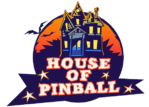If you’re searching for a pinball machine for sale, there’s one part you shouldn’t overlook—the power supply. It’s the heartbeat of the machine. Without a healthy power source, your flippers go limp, lights stay dark, and gameplay becomes unpredictable—or impossible.
At House of Pinball, we inspect, test, and replace power supplies as part of every sale. But whether you’re buying your first machine or maintaining a classic, understanding the basics of power supply troubleshooting and repair will save you time, money, and frustration.
This guide breaks it all down—clearly and simply—so you can buy smart and play with confidence.
🔌 Why the Power Supply Matters
The power supply delivers stable voltage to every system inside your pinball machine:
- Flippers and bumpers (high voltage)
- Lights, solenoids, switches (low voltage)
- CPU and sound boards (regulated voltage)
Even small power issues can lead to:
- Resetting during play
- Dim or flickering lights
- Non-responsive flippers or coils
- Boot-up failures
Knowing how to test and repair these issues helps you make better buying decisions—and prevents headaches later.
🧰 Tools You’ll Need
Before diving into troubleshooting, gather a few essentials:
- Digital multimeter (must-have for voltage testing)
- Basic screwdrivers (to access boards)
- Soldering iron (for minor repairs)
- Replacement fuses and connectors
- Service manual or schematic for your specific machine
⚙️ Understanding Common Pinball Power Supplies
Depending on your machine’s generation, you’ll encounter different styles:
| System | Years | Type of Power Supply |
|---|---|---|
| EM (Electromechanical) | Pre-1977 | Transformer-based, simple wiring |
| System 3–7 (Williams) | Late 70s–80s | Linear power supply board |
| System 11 / WPC | Late 80s–90s | Regulated switching + driver board |
| Modern Stern / JJP | 2000s+ | Modular switch-mode PSUs (SMPS) |
🎯 Buyer Tip: When evaluating a pinball machine for sale, always ask if the power supply is original, rebuilt, or replaced. Aging components are a red flag.
🛠️ Common Power Supply Problems & How to Fix Them
⚡ 1. Machine Won’t Boot
Symptoms: No lights, no sounds, no display.
Likely Causes:
- Blown main fuse
- Dead power supply
- Transformer failure
Fix:
- Check power cord and outlet first
- Use a multimeter to test AC voltage at the transformer
- Test DC output on the power board (usually labeled +5V, +12V)
- Replace blown fuse only after finding the cause
✅ Pro Tip: Never swap a fuse with a higher amp rating—it can cause further damage.
🔄 2. Game Resets During Play
Symptoms: Machine reboots when multiple solenoids activate (like multiball or flipper use).
Likely Causes:
- Weak 5V regulator
- Failing bridge rectifier
- Loose power connectors
Fix:
- Test +5V under load (should stay steady above 4.9V)
- Reseat all connectors to the power board
- Replace the 5V regulator (LM323 or similar) if output is unstable
🎯 Buying Tip: A reset-prone machine often signals deeper board issues. Ask sellers for repair logs or test reports.
💡 3. Dim or Flickering Lights
Symptoms: Inserts or GI (general illumination) flicker, especially on older machines.
Likely Causes:
- Bad connectors (especially Molex)
- Aging bridge rectifier
- Low voltage from power board
Fix:
- Replace GI connector pins (common in System 11/WPC)
- Reflow solder on rectifier terminals
- Upgrade to LED-compatible voltage regulators if using LEDs
✅ Upgrade Tip: At House of Pinball, we offer LED-ready rebuilds to handle modern lighting loads.
🔥 4. Fuses Keep Blowing
Symptoms: You replace a fuse, turn on the machine—and it blows again.
Likely Causes:
- Shorted coil or diode
- Faulty bridge rectifier
- Miswired playfield component
Fix:
- Identify which circuit the fuse protects
- Test coils and diodes for continuity
- Check for wire rub-through or pinched wires under the playfield
- Replace the rectifier if AC to DC conversion is unstable
⚠️ Safety Note: Always unplug the machine before testing components. Use caution when dealing with high voltage.
🛒 What This Means When You’re Buying
Here’s how your new knowledge applies directly when shopping for a pinball machine for sale:
| Question to Ask | Why It Matters |
|---|---|
| Has the power supply been rebuilt or replaced? | Original parts over 20 years old often fail. |
| Are the voltage outputs tested and stable? | Protects your CPU and sound boards from damage. |
| Have connectors and fuses been upgraded? | Prevents flicker, resets, and failure under load. |
| Is the machine LED-converted? | LEDs require stable voltage; not all supplies support this. |
✅ At House of Pinball, we include full voltage test results, rebuilt power boards, and upgraded connectors in every machine we sell.
🧠 When to Replace vs Repair
| Condition | Repair | Replace |
|---|---|---|
| Burnt connectors | ✅ | — |
| Weak 5V output | ✅ | — |
| Cracked PCB | — | ✅ |
| Constant fuse blowing | ✅ (if traceable) | ✅ (if not fixable) |
| AC transformer failure | — | ✅ (rare, but critical) |
🎯 Replacement Tip: Modern aftermarket boards are more reliable and efficient—great for home use.
⚡ House of Pinball Does It Right
We take power seriously—because a healthy supply means reliable, worry-free play.
✔️ Every machine is voltage-tested before sale
✔️ Power boards are cleaned, recapped, or replaced
✔️ Connectors and fuses are inspected and upgraded
✔️ We provide full power diagnostics with your purchase

